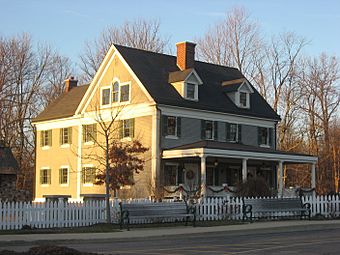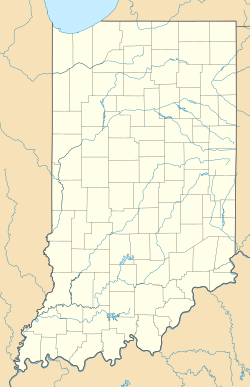West-Harris House facts for kids
Quick facts for kids |
|
|
West-Harris House
|
|

West-Harris House, January 2013
|
|
| Location | 10595 Eller Rd., Fishers, Indiana |
|---|---|
| Area | 2 acres (0.81 ha) |
| Built | c. 1826, c. 1895 |
| Architect | Thomas West (original owner, 1826) |
| Architectural style | Colonial Revival |
| NRHP reference No. | 99000297 |
| Added to NRHP | March 23, 1999 |
The West-Harris House, also called the Ambassador House, is a historic home in Fishers, Indiana. It's located in Hamilton County, Indiana, at 106th Street and Eller Road. This two-story house looks like a letter "L" and is built in the Colonial Revival style. It has a big attic and a chimney in the middle.
The house also features a wide front porch with a sloped roof. Large, fancy Palladian windows are on the ends of the roof. Parts of the house are from an original log cabin built around 1826. This cabin was later made bigger and updated.
In 1996, the house was moved to save it from being torn down. It traveled about 3 miles (4.8 km) from its first spot. Now, it stands at Heritage Park at White River in Fishers. The West-Harris House was added to the National Register of Historic Places in 1999. Today, it serves as a local history museum. It's also used for community events and can be rented for private parties.
The house is named after two of its past owners. These are Thomas and Sarah West, and Addison and India Harris. The West family built the first two-room log part of the home around 1826. This was on their land at what is now 96th Street and Allisonville Road in Fishers.
Addison Harris bought the property in 1880. He had the house made larger and updated around 1895. Harris was a well-known Indianapolis lawyer. He also served in the Indiana Senate from 1876 to 1880. Later, he was a U.S. diplomat, serving as an Envoy to Austria-Hungary from 1899 to 1901.
His wife, India Harris, was very active in the arts in Indianapolis. From 1905 to 1907, she was president of the Art Association of Indianapolis. This group later became the Indianapolis Museum of Art and the Indiana University – Purdue University at Indianapolis's Herron School of Art and Design. The house got its nickname, Ambassador House, because of Addison Harris's work as a diplomat in Vienna, Austria. This was during President William McKinley's time in office.
Contents
The West-Harris House Story
Thomas and Sarah West were among the first settlers in Hamilton County, Indiana. They built the first two-room log part of the house around 1826. This was on their land at what is now 96th Street and Allisonville Road in Fishers. In 1871, William Hartman bought the property from the West family's heirs. He also bought more land to make the farm bigger.
Addison and India Harris's Time
Addison C. Harris (1840–1916) was a famous Indianapolis lawyer. He was also a member of the Indiana Senate from 1876 to 1880. Harris bought the property in 1880. Around 1895, he had the house updated and made larger.
Addison and his wife, India Crago Harris (1848–1948), used the house as a summer home. The house is called Ambassador House because of Addison Harris's work as a diplomat. He served as the U.S. Envoy to Austria-Hungary from 1899 to 1901. This was when President William McKinley was in charge.
India Harris was very involved with the Art Association of Indianapolis. This group later became the Indianapolis Museum of Art and the Indiana University – Purdue University Indianapolis Herron School of Art and Design. She was on its board for many years. She also led the group as its fifth president from 1904 to 1907. India Harris also started Herron's reference library.
After her husband died in 1916, India Harris kept the home until her death in 1948. She left the property to Indiana University. The university then sold off parts of the land over several years.
Saving the Historic Home
In 1995, the Washington Park Cemetery Association bought the home and 192 acres (78 hectares) of land around it. The cemetery group split their land into three parts. They kept one part to make a nearby cemetery bigger. They gave another part to the Town of Fishers for a public park. This park became Heritage Park at White River. The third part, which included the West-Harris home, was sold for new buildings.
In 1996, the Fishers town council and local groups worked to save the historic house. They wanted to protect it from being torn down for new businesses. The Town of Fishers took ownership of the house in 1996. They oversaw its move to town-owned land at 106th Street and Eller Road. This is where Heritage Park at White River is now. The park is about 3 miles (4.8 km) from where the house first stood. The house's pillars and a stone outbuilding were given to the Town of Fishers in 1997.
The West-Harris House Today
The Ambassador House has been fully restored. It now serves as a local history museum. It's also a place for community events and can be rented for private gatherings. You can find it at Fishers Heritage Park at White River.
What the House Looks Like
Outside the House
The West-Harris house is shaped like an "L" and has two stories. It's built in the Colonial Revival style. It has a large attic and a chimney in the center. The house features a wide front porch with a sloped roof. Large Palladian windows are on the ends of the roof.
The first two-room log part of the house was built around 1826. It was made bigger around 1895. New parts added to the home included a stair hall and a two-story kitchen area in the back. A back porch and an attic were also added. The original log outside was covered with wood siding during the updates. The inside was covered with plaster. The house sits on a brick foundation and has a shingle roof. Two rooms still show the original log construction from around 1826. You can see the original logs from the basement.
The main front of the house faces south and has two and a half stories. On the first floor, there's a central door with windows on each side. The second-floor windows are right above the first-floor windows. The attic has two dormer windows. The corners of the house have simple, classic-looking pilasters. The west side of the house has a large Palladian window on the roof end. The east side is similar, but it has a large bay window. The north side has a door in the middle of the first floor. A window is centered above it on the second floor. Its roof end has three windows, one on the first floor and two on the second.
Inside the House
The main part of the house has two rooms on each floor. These rooms are around a central chimney. A stair hall was built across the north side of the house. This hall leads to the kitchen area on the west side and the basement below it. A door on the east end of the hall goes to a back porch. The front rooms of the house and two small rooms above the kitchen also connect to the stair hall. The second floor has two bedrooms. There are two bathrooms at each end of the stair hall. You can get to the attic using pull-down stairs in the hallway.
The kitchen area has a large workspace and a small room next to the kitchen on the first floor. The second floor has two small rooms.
Other Buildings
There's a one-story rectangular building outside. People believe it was used as an ice house or a summer kitchen. It's made of stone and has a simple gable roof.
Why It's a Historic Place
Buildings that have been moved are usually not put on the National Register of Historic Places. However, in 1999, an exception was asked for this house. The main reasons given were because of Addison and India Harris owning the home. There are no other buildings left from their most important time in Indianapolis. Also, moving the house was necessary to save it from being torn down. The West-Harris home was added to the National Register in 1999.



